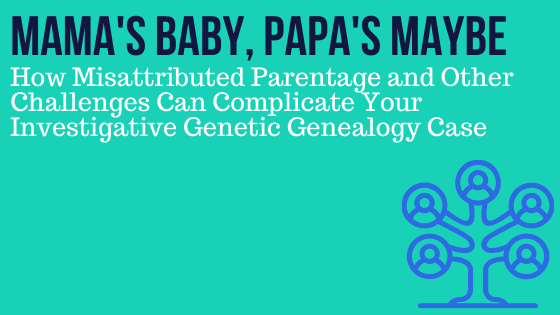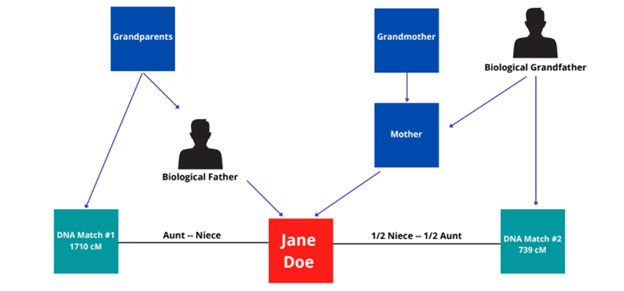DNA Doe Project is a nonprofit organization whose mission is to name the nameless – to identify John and Jane Does using investigative genetic genealogy. While the humanitarian efforts of the group are the primary focus, I am pleased to write this guest blog for our friends at ISHI to share knowledge and contribute to the field of forensic science.
Written by: cairenn binder, dna doe project
In my years working with the DNA Doe Project, one conclusion has been easy to reach: families are complicated. The practice of genetic genealogy regularly reveals surprises and secrets that were easily concealed just decades ago. Many of us on the DNA Doe Project team have solved our own family mysteries and misattributed parentage events using DNA. As a result of how frequently misattributed parentage is observed in our field, it is second nature for an investigative genetic genealogist to suspect it as soon as something in a case seems “off”. One such case inspired the poster I presented at ISHI 32 in Orlando, Florida: Mama’s Baby, Papa’s Maybe: How Misattributed Parentage and Other Challenges Can Complicate Your IGG Case.
The case, anonymized for privacy of the family, involved a young female homicide victim who had remained unidentified for many years. Initially, her DNA matches indicated that the case would be straightforward and quickly solved. Her top match was 1,710 centimorgans – later revealed to be a full aunt. However, the top match’s sibling, a male – now deceased, had never acknowledged paternity of a child born at the time that our Jane Doe would have been born. This was our first dead end of the case – we knew who Jane Doe’s father was, but had no way to identify her mother.
The next two top matches, unrelated to Jane Doe’s father, helped us to figure out Jane Doe’s maternal side. We focused on one particular couple who we knew, from DNA matches, to be a probable ancestor of Jane Doe. Since this couple had nine children, it was helpful that we knew Jane Doe’s mitochondrial DNA haplogroup. We used this information in comparison with one of the DNA matches to rule out some of the downlines, eliminating several of the children as potential ancestors of Jane Doe.
Upon voluntary target-testing of a descendant of the couple’s middle child, we identified the descendant as a half-aunt to our Jane Doe. Unfortunately, the woman provided our team with our second dead end. She divulged that her father, while in the military, had possibly fathered a child with a woman. However, her father was deceased and had never revealed the name of the woman. This was the second incidence of misattributed paternity in this Jane Doe case – two consecutive generations!
To solve the case, our team isolated Jane Doe’s maternal grandmother’s line by eliminating all DNA matches that matched her aunt and half-aunt. Working with the remaining matches provided us with common ancestor couples in the maternal line, which eventually led to identification of Jane Doe’s maternal grandmother. Her children were contacted by our law enforcement agency partners, leading quickly to Jane Doe’s identity.
While this case presented many challenges, it was also an excellent learning experience for our team. The challenges of the case required close collaboration with our law enforcement partners, who were tasked with speaking with potential family members and treading carefully where long-buried family secrets were involved. We applied new techniques in this case, including the use of the mitochondrial DNA haplogroup to eliminate descending matrilines. This technique has proven useful in other cases I have encountered since.
At DNA Doe Project, sharing our work is necessary to continue our growth and development. Our organization was the first ever to solve an unidentified decedent case using investigative genetic genealogy, and we continue to expand our reach with each passing year. With over sixty solved cases to date and many more in research, we hope to provide resolution to the thousands of families missing loved ones.
WOULD YOU LIKE TO SEE MORE ARTICLES LIKE THIS? SUBSCRIBE TO THE ISHI BLOG BELOW!
SUBSCRIBE NOW!




